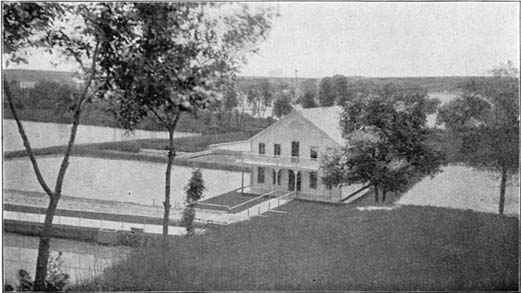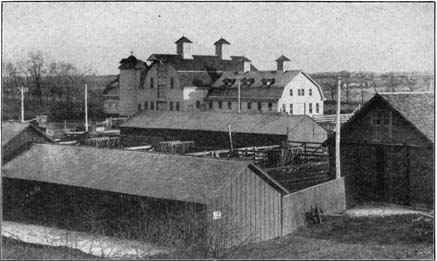Nebraska State Fish Hatchries |
Dairy Barn at the State Farm The Experiment Station and the School of Agriculture. This department of the State University is carried on at a distance of three miles from the college campus and the tract of land which it occupies is known as the State Farm. The present farm of three hundred and twenty acres was secured in 1874. During this year the first experiments were made in the growing of sugar beets and mangel-wurzels for feed, in tests of soils, in the feeding of pigs and the raising of blooded cattle. Sorghum sugar was made and grains and grasses were experimented with to some extent. The Experiment Station was not connected with the agricultural department until 1887, when, by an act of Congress, an annual appropriation of $15,000.00 was set aside for its maintenance. Dr. Charles E. Bessey, Dean of the Industrial College and Professor of Botany, was made the first Director of the Experiment Station. He was succeeded in 1889 by Dr. Lewis F. Hicks, the Professor of Geology, who was in turn succeeded the next year by Prof. H. H. Nicholson, Professor of Chemistry. In 1893 C. L. Ingersoll, Professor of Agriculture, became Director, and served until July 1, 1895. He was succeeded by the Chancellor of the University, George E. MacLean, who resigned in 1899. Prof. T. L. Lyon, the agriculturist, performed the duties of the office in the capacity of Acting Director until Chancellor E. Benjamin Andrews became Director, October, 1900, who resigned this position in July, 1901, and the present incumbent, Edgar A. Burnett, Professor of Animal Husbandry since 1899, was chosen Director of the Station. This station has directed more effort toward the understanding of hog cholera and its preventatives than any other. Its investigation of the cause of cornstalk disease has also been very exhaustive. In 1902, this station had the credit of the important discovery that prussic acid exists in sorghum, under fixed conditions. The state dairy industry has been greatly benefitted by the researches and scientific tests made by the institution. The School of Agriculture was founded in 1895, with an attend- |
 |
 |
 |
 |
|
@ 2002 for the NEGenWeb Project by Pam Rietsch, Ted & Carole Miller |
|||

